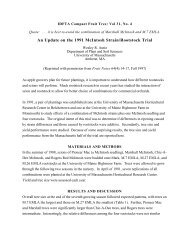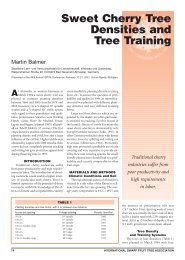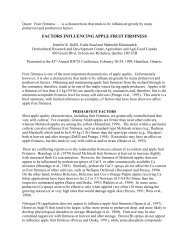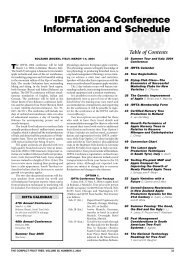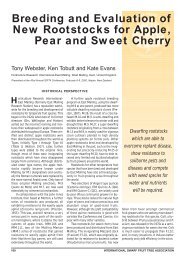Management of High Density Pear Orchards - Virtual Orchard
Management of High Density Pear Orchards - Virtual Orchard
Management of High Density Pear Orchards - Virtual Orchard
- No tags were found...
Create successful ePaper yourself
Turn your PDF publications into a flip-book with our unique Google optimized e-Paper software.
growth habits <strong>of</strong> the tree. These differencesin branch diameter should be taken intoaccount during the winter pruning. Thesebranches can be classified as dominant oras dominated structures and the response<strong>of</strong> the same pruning cut will be totally differentwhen it is made in dominant twig orin dominated branch, even when thebranches have the same age (Fig. 1).EARLY PRODUCTIVITYFor intensive pear orchards early productivityis a must for economical reasonsas well as for natural growth control. Thefirst pears should be harvested in the secondyear after planting with productivityestimated at 3 to 5 kg/tree (6.6 to 11 lb/tree). Gibberellin treatments can help toimprove this early productivity on youngConference trees. In Table 3 some resultsare summarized with different gibberellintreatments applied during full bloom ontrees in their second season after planting.This trial was made on young Conferencetrees on Quince Adams in the secondyear after planting. The GA 3 treatment inthis trial was made as tablets <strong>of</strong> 10 g(0.022 lb) each containing 1 g active ingredientper tablet (0.0033 lb). The GA 4/7 was appliedas Regulex, containing 9 g/l GA 4/7(0.02 lb). For fruit set improvement, the GA 3treatment is clearly stronger than the GA 4/7 .The different forms <strong>of</strong> GA 4/7 have a comparablepositive effect on fruit set. For a fertilepear cultivar like Conference, it is not alwaysnecessary to take the strongest fruit set effect.Splitting up the total dose <strong>of</strong> GA 4/7 in twotreatments, one during full bloom on the 2-year-old wood and one during full bloomTABLE 3on the 1-year-old wood some days later, canbe interesting during variable climatologicalconditions. Also the combination <strong>of</strong> alow dose <strong>of</strong> GA 3 and half dose <strong>of</strong> GA 4/7looks promising. On young trees the risk fornegative effects on fruit size or on return tobloom is very limited but on adult trees riskshould be taken into account.The global result <strong>of</strong> these gibberellinapplications is different from year to yearwith sometimes substantial differences butin other years with no differences. The fruitset improvement is only one factor in thewhole series <strong>of</strong> phytotechnical measuresthat determines the final result.NUTRITIONMost <strong>of</strong> the Belgian pear orchards haveno possibilities for irrigation or fertigation.Nitrogen and potassium are two importantnutritional elements for pear growingin Belgium, nitrogen for an optimal fruitset and potassium for an optimal fruitquality. After the loss <strong>of</strong> chloormequat(CCC) as growth regulator there is a tendencyto reduce nitrogen partially or evencompletely in Belgian pear growing. Thiscould be negative for the normal fruit setcapacity <strong>of</strong> the flowers which need nitrogenavailable in the NO 3 form duringbloom and immediately afterwards duringthe process <strong>of</strong> flower drop and fruitletdrop. Postharvest applications <strong>of</strong> nitrogenare <strong>of</strong>ten used to improve the nitrogen reservelevel in the tree and to avoid vegetativegrowth reactions on the trees. Postharvestnitrogen can be applied by the roots oras a leaf nitrogen application with urea.Part <strong>of</strong> the nitrogen should always be givenFruit set improvement on young Conference pear trees with different gibberellin treatments (ns=nosignificance; *=significance <strong>of</strong> 95%; **=significance <strong>of</strong> 99%).% fruit set 2 yr wood after % fruit set 1 yr wood afterflower drop June drop flower drop June drop # pears/tree1. Untreated 18.4 8.7 25.2 11.5 33.62. GA 3 (10 tablets/ha) 35.3 ** 25.5 ** 32.8 ** 19.6 ** 44.0 ns3. GA 4/7 (1.2 l/ha) 23.7 ns 15.1 ns 23.4 ns 14.7 * 36.4 ns4. Promalin (0.6 l/ha) 22.2 ns 15.1 * 25.9 ns 14.6 ns 37.1 ns5. GA 3 (10 tabl.) + 27.1 * 18.1 ** 27.8 ns 20.5 ** 34.6 nsGA 4/7 (0.6 l/ha)6. GA 4/7 (2 x 0.6 l/ha) 24.9 ns 16.7 * 32.5 ** 20.1 ** 39.9 nssome weeks before bloom (20 to 30 kgN/ha; 17.8 to 26.7 lb/acre). This ensuresthat nitrogen will be available duringbloom for optimal fruit set. Early leafanalysis can give useful information on thenitrogen content during the floral andpostfloral period.CONCLUSION<strong>Pear</strong> growing in high density plantingsis possible with different training systemsbut there are important differences inlabor needed for each system. Planting materialfor intensive growing should be wellfeathered2-year-old trees with at least 6feathers. Information on flower bud qualityon different structures in the pear treecan help improve the regularity <strong>of</strong> theyield. The best flower bud quality on pearis found on the terminal flower buds onshort brindle shoots. Flower buds in terminalposition give higher fruit set percentagesthan in other positions. <strong>Pear</strong> treeshave an epitonic behavior, which meansthat the development <strong>of</strong> flower buds andshoots is better on the upper side <strong>of</strong> thebranches. The use <strong>of</strong> gibberellins is necessaryto guarantee the early productivity <strong>of</strong>young pear trees. Nitrogen is important fora regular fruit set on young pear trees andshould be available during bloom and justafter bloom.REFERENCESBrunner, T. and I.K. Kecskes. 1990. Physiological fruittree training for intensive growing. Budapest:Akademiai Kiado.Demayer, L. and J.C. Deckers. 1984. Flower bud qualityin the pear cultivar Doyenné du Comice:1982–1983 trials. Acta Hort. 149:153–160.Rom, C.R. and B.H. Barritt. 1990. Spur development<strong>of</strong> Delicious apple as influenced by position,wood age, strain and pruning. HortScience25(12):1578–1581.Volz, R.K., E.W. Hewett and D.J. Wooley. 1992. Applefruit quality variation within the tree canopyat harvest. Postharvest Physiology Conference,California.*Research subsidized by the Ministry <strong>of</strong>Small Enterprises, Traders and Agriculture,Administration for Researchand Development120 INTERNATIONAL DWARF FRUIT TREE ASSOCIATION



